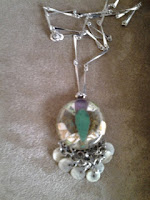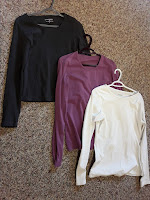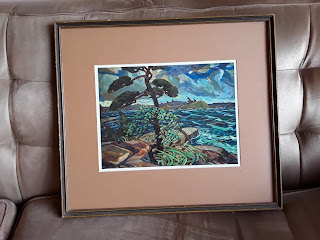Part One: Don't Overthink This It's late fall, and she's trying to build a winter-wearing plan.
She realizes that
the colours and the outfits she came up with for early fall aren't going to change much. And since she's not going to the Arctic, most of what she's already wearing will still work through the winter.But it's always interesting to curate things a bit, maybe find new connections.
Part Two: Winter is somewhere between September and spring
She decides to try something that's worked for her before: choosing Canadian paintings as inspiration. A familiar one by a Group of Seven artist, and a new favourite seen at an antiques market.
Arthur Lismer, A September Gale, Georgian Bay (1921)
She and her spouse both noticed the Houstoun picture, and they agree that it's a) amazing but b) way out of their budget. Oh well, she thinks, she will probably be able to visit it again there, since it's not likely to be flying off the wall at that price.
Part Three: Walking Backwards
The normal way to plan a wardrobe is to pick clothes, make outfits, and add accessories to match, right? But she has always been one to do things the wrong way round.
This thrifted scarf, she now thinks of as the September Gale scarf.
This one (from an antiques market) is the "Houstoun original."
And this one is Houstoun #2, with the dark leaves from September Gale thrown in.
("Poetic Nature Foliage" pink scarf from Northern Reflections)
Pink earrings like the rocks and the hills (thrifted)
Blue earrings like the sky (thrifted)
Green earrings like the waves (thrifted, gallery gift shop, and antiques market)
Teal and white bracelets (Fierce Lynx Designs)
Purse (thrifted)
Grey and pink scarf/shawl (thrifted)
Part Four: What goes underneath
4 cardigans and pullovers
Teal-green zippered fleece shawl/poncho (thrifted). This is a multiway piece of clothing, one of those magic garments with snaps that can zip, unzip, and turn it into almost anything, like a wrap top. She appreciates the fact that it was designed and made in Canada.

Grey and blue long cardigan (thrifted for a whole dollar)
Another grey cardigan (thrifted)
Cotton cable-knit pullover (consignment store four years ago)
11 button-ups, turtlenecks, and t-shirts
4 pairs of pants (jeans, cords, and leggings)
1 sweater dress
Hmm...21 pieces? She looks carefully at what she has and what she's likely to be wearing, and decides to add three more:
Blue and white striped shirt (thrifted), because it's useful
Khaki pants (thrifted), because sometimes she wants a lighter colour
Purple jersey dress (thrifted), because sometimes she wants something not so grey
Outerwear and shoes (not counted)
Jean jacket (thrifted)
Warm jacket, muffler, hat, gloves, snow boots
Ankle boots (Walmart clearance last year)
Arcopedico flat shoes (thrifted)
Allbirds Mizzles
Making Outfits
The end of the story
They live three-quarters of an hour from an outdoor flea market. On the weekend before it closes for the season, her spouse says, "Let's go one last time. Maybe there will be some good deals."
It turns out to be a shivery morning, but one thing she spots hanging on a rack of pictures makes it all worthwhile:
Yes, for less than the cost of a Dinner for Two with Spring Rolls, she now has a print of Lismer's September Gale. Her spouse cleaned the frame a bit (because he's nice like that), and it's now hanging over her workspace computer.
And the Houstoun can stay where it is.








































